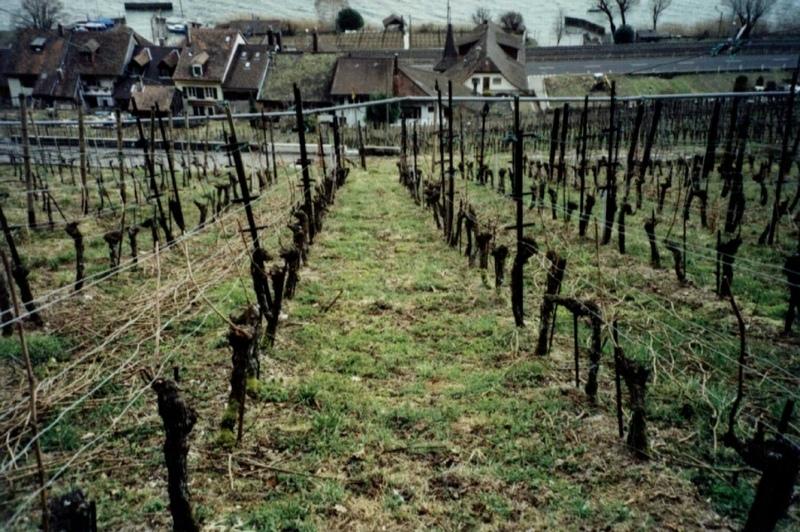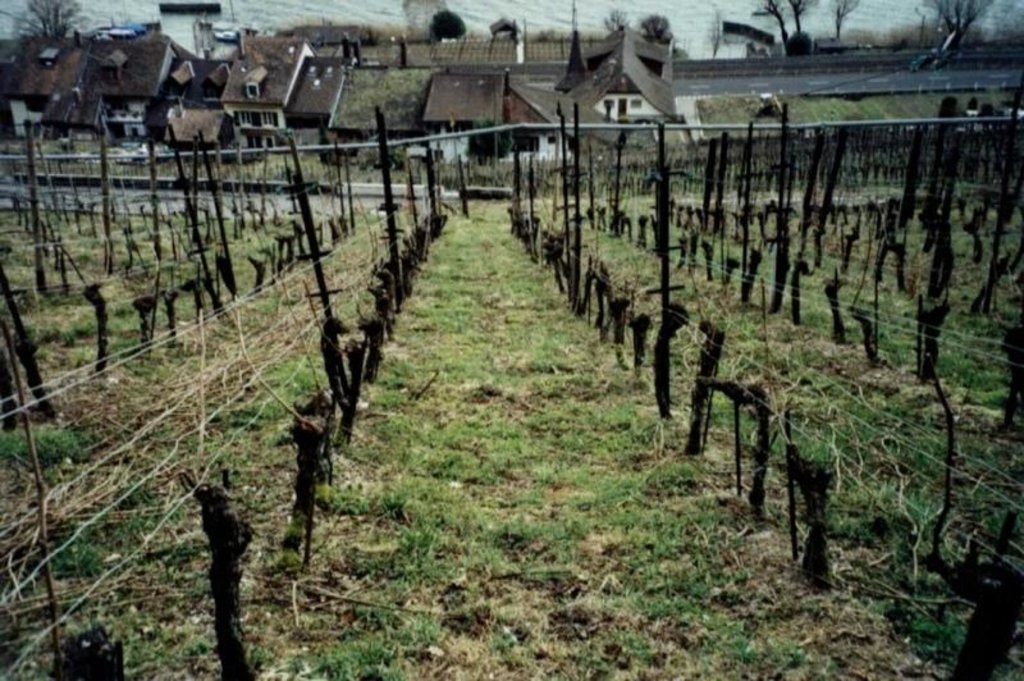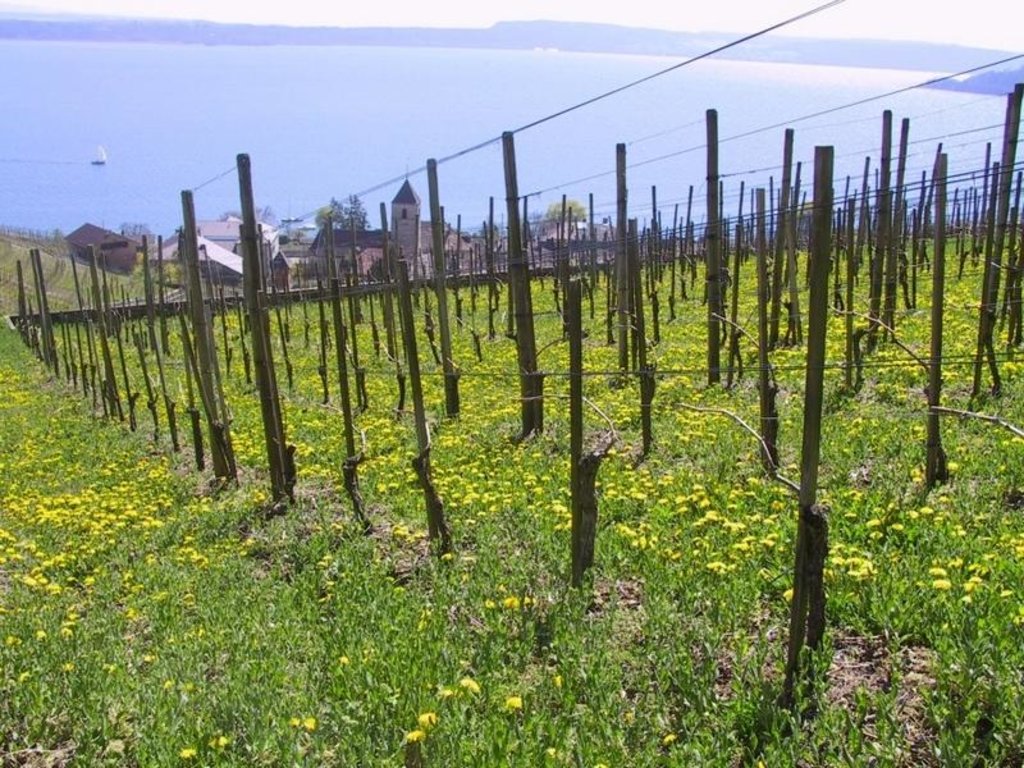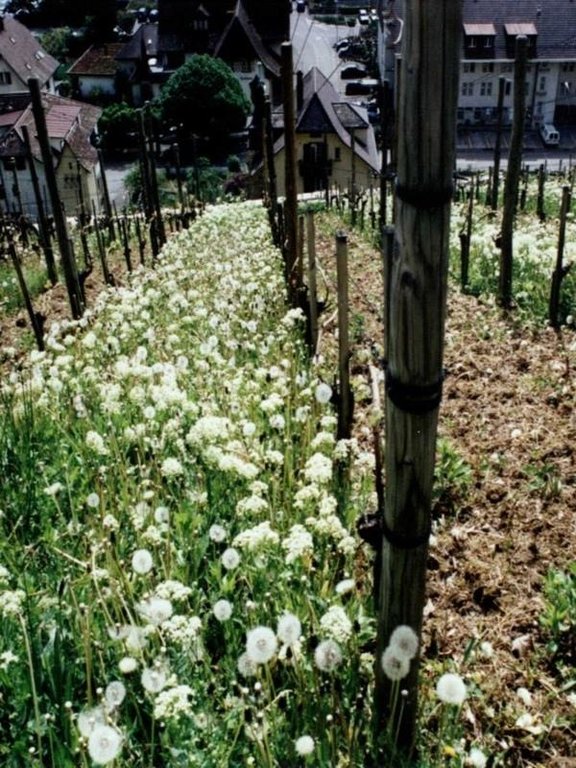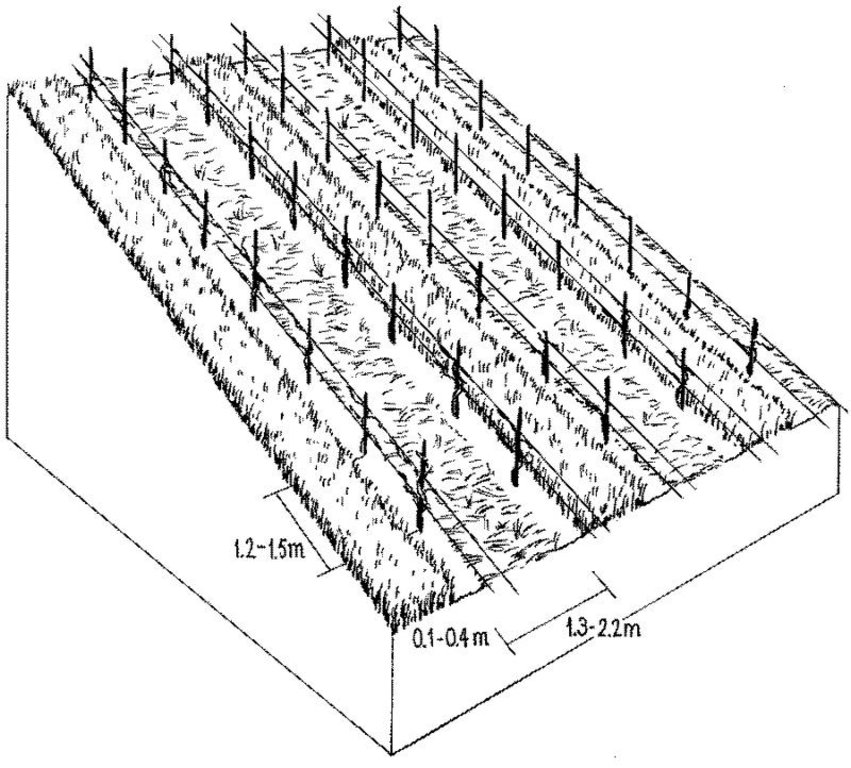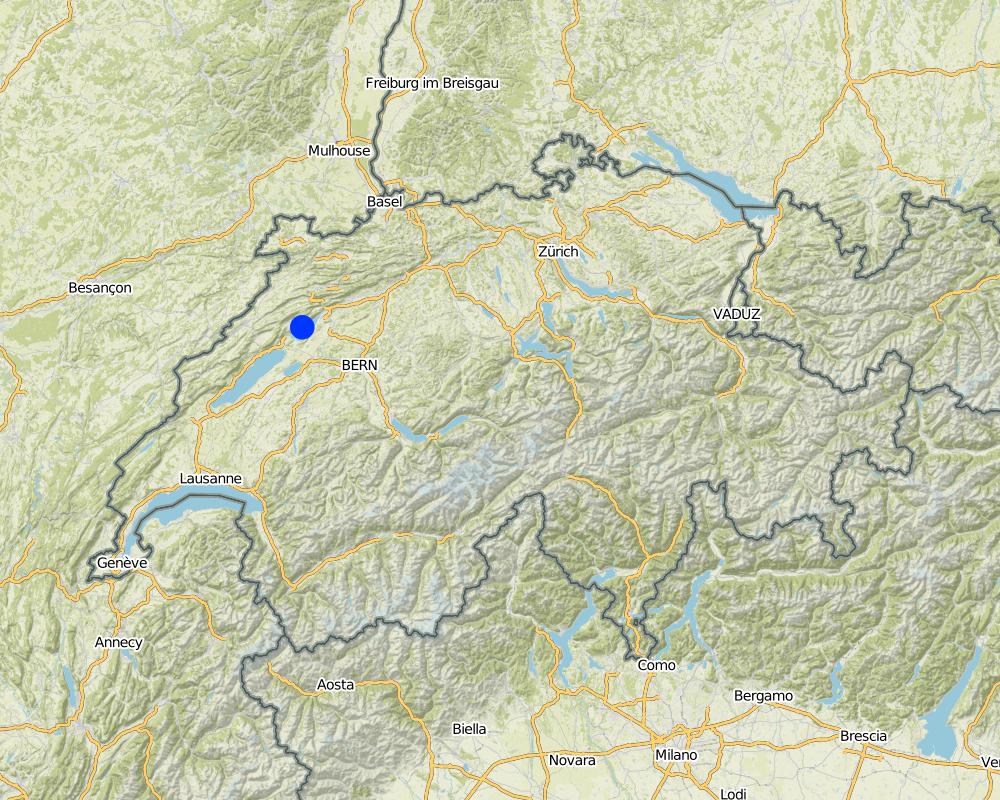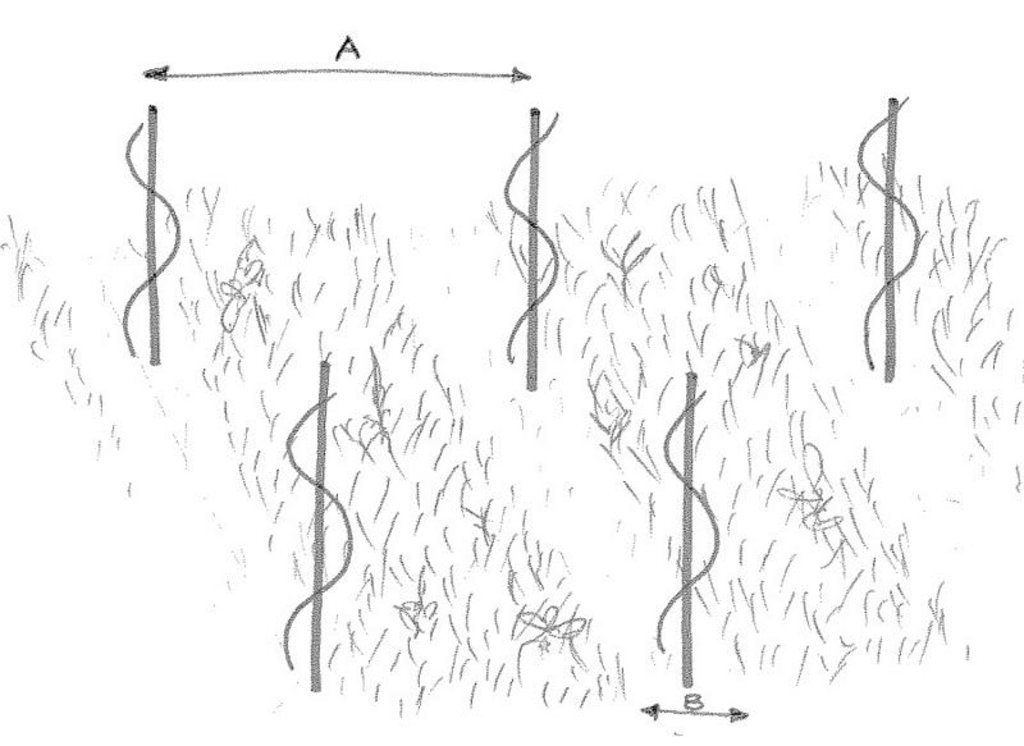Green cover in vineyards [Suisse]
- Création :
- Mise à jour :
- Compilateur : Nicole Guedel
- Rédacteur : –
- Examinateurs : Fabian Ottiger, Deborah Niggli, Alexandra Gavilano
Begrünung von Rebflächen (im Direktzug / in der Falllinie bewirtschaftet)
technologies_1018 - Suisse
Voir les sections
Développer tout Réduire tout1. Informations générales
1.2 Coordonnées des personnes-ressources et des institutions impliquées dans l'évaluation et la documentation de la Technologie
Spécialiste GDT:
Weissenbach Peter
Federal Research Station for fruit-growing, viticulture and horticulture -FAW
Suisse
Spécialiste GDT:
Spring Jean-Laurent
Federal Research Station for fruit-growing, viticulture and horticulture-RAC
Suisse
exploitant des terres:
Louis Hannes
Louis Weinbau
Suisse
exploitant des terres:
Hasler Lukas
Hasler Weinbau
Suisse
Nom du projet qui a facilité la documentation/ l'évaluation de la Technologie (si pertinent)
Book project: where the land is greener - Case Studies and Analysis of Soil and Water Conservation Initiatives Worldwide (where the land is greener)Nom du ou des institutions qui ont facilité la documentation/ l'évaluation de la Technologie (si pertinent)
Federal Research Station for fruit-growing, viticulture and horticulture (FAW/RAC) - SuisseNom du ou des institutions qui ont facilité la documentation/ l'évaluation de la Technologie (si pertinent)
CDE Centre for Development and Environment (CDE Centre for Development and Environment) - Suisse1.3 Conditions relatives à l'utilisation par WOCAT des données documentées
Le compilateur et la(les) personne(s) ressource(s) acceptent les conditions relatives à l'utilisation par WOCAT des données documentées:
Oui
1.5 Référence au(x) Questionnaires sur les Approches de GDT (documentées au moyen de WOCAT)
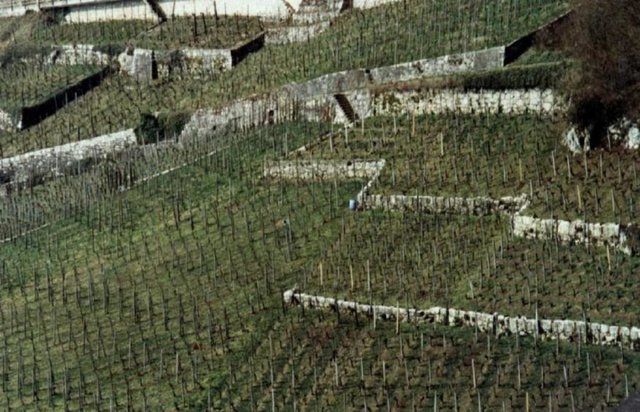
Farmer initiative within enabling environment [Suisse]
Initiative and innovation of land users, stimulated by government's technical and financial support.
- Compilateur : Nicole Guedel
2. Description de la Technologie de GDT
2.1 Courte description de la Technologie
Définition de la Technologie:
Naturally growing or sown perennial grasses/herbs providing cover
between rows in sloping vineyards, where the vines are usually oriented up and down slope.
2.2 Description détaillée de la Technologie
Description:
The area around Lake Biel has a strong wine growing tradition dating back several centuries. The vineyards are, for micro-climatic reasons, sited on the southwest facing slope close to the lake. Annual rainfall is about 1,000 mm, with at least one erosive storm per year, and the soils are highly erodible. In conventional viniculture all weeds are controlled chemically. The ‘green cover technology’ comprises sown, or naturally occurring, perennial grasses and herbs which form a biodiverse green cover - a ‘living mulch’ - over the soil surface between vine rows. In this region, rows are generally oriented up and down the slope for ease of machine operation. Green cover may also be applied where vines are grown on narrow bench terraces. The purpose is the prevention of soil degradation, especially soil erosion by water. Secondary purposes include protection of the soil surface from compaction when using mechanised equipment, and promotion of biodiversity.
Green cover is generally established naturally - except on contour-planted terraced vineyards, where cover is planted for immediate stabilisation of the terraces. To avoid competition, a 10-40 cm diameter zone around the freshly planted vines is kept free from vegetation: during the three year establishment period it is removed by hoe, later it is controlled with herbicides (either as a strip along vine rows or around individual vines). The topsoil between the vine rows is ripped every few years with an implement pulled by a small caterpillar tractor. The green cover vegetation is cut, chopped and left as mulch several times using special mulching machines. These operations are not carried out over the whole field at once: alternate rows are left untouched to ensure that some vegetation remains to maintain biodiversity. When these rows redevelop their green cover, the others are then treated. This is effectively a minimum tillage system, building up organic matter in the soil. Cutting and mulching, in addition to ripping, serves to circulate nutrients. Mineral fertilizer and herbicides are applied once a year around the vines. Experiments with the technology started in the 1970s, but green cover has now become standard practice.
Supportive measures include not removing crop residues (from vineyards) which are chopped later - simultaneously with the cover crop (grass) - to protect the soil surface, and irrigation in dry years.
2.3 Photos de la Technologie
2.5 Pays/ région/ lieux où la Technologie a été appliquée et qui sont couverts par cette évaluation
Pays:
Suisse
Région/ Etat/ Province:
Canton of Berne
Autres spécifications du lieu:
Lake of Biel
Commentaires:
The technology is applied in all wine growing regions of Switzerland, but under different conditions
Map
×2.6 Date de mise en œuvre de la Technologie
Si l'année précise est inconnue, indiquez la date approximative: :
- il y a moins de 10 ans (récemment)
2.7 Introduction de la Technologie
Spécifiez comment la Technologie a été introduite: :
- par le biais de projets/ d'interventions extérieures
Commentaires (type de projet, etc.) :
The development of green cover in vineyards was (also on the international level) essentially promoted and supported by the Federal Research Station for fruit-growing, viticulture and horticulture in Wädenswil (Canton of Zürich)
3. Classification de la Technologie de GDT
3.2 Type(s) actuel(s) d'utilisation des terres, là où la Technologie est appliquée

Terres cultivées
- Cultures pérennes (non ligneuses)
- Plantations d’arbres ou de buissons
Plantations d'arbres et d'arbustes - Précisez les cultures:
- raisins
Nombre de période de croissance par an: :
- 1
Précisez:
Longest growing period in days: 210Longest growing period from month to month: Apr - Oct
Commentaires:
Major land use problems (compiler’s opinion): The main problem was decreasing soil fertility, especially through soil erosion by water, caused by lack of soil cover and intensive cultivation. There were associated negative offsite effects including sand/sediment deposition and contamination of groundwater by nutrients. This became a serious problem from the 1960s when the traditional labour-intensive methods were superseded by a mechanised-industrial agricultural system.
Type of cropping system and major crops comments: a vine plantation is established for a period of 20-40 years (lifetime of a vine). Some farmers make one year of fallow between the destruction of the old and the establishment of a new plantation.
3.4 Approvisionnement en eau
Approvisionnement en eau des terres sur lesquelles est appliquée la Technologie:
- mixte: pluvial-irrigué
Commentaires:
Water supply: rainfed, mixed rainfed - irrigated
3.5 Groupe de GDT auquel appartient la Technologie
- Amélioration de la couverture végétale/ du sol
- mesures en travers de la pente
3.6 Mesures de GDT constituant la Technologie

pratiques agronomiques
- A7: Autres

pratiques végétales
- V5: Autres
Commentaires:
Main measures: agronomic measures, vegetative measures
Specification of other agronomic measures: minimum tillage: cutting & mulching, ripping
Specification of other vegetative measures: cover cropping
Type of agronomic measures: mulching, manure / compost / residues, mineral (inorganic) fertilizers, breaking compacted topsoil
Type of vegetative measures: scattered / dispersed
3.7 Principaux types de dégradation des terres traités par la Technologie

érosion hydrique des sols
- Wt: perte de la couche superficielle des sols (couche arable)/ érosion de surface
- Wo: effets hors-site de la dégradation

dégradation chimique des sols
- Cn: baisse de la fertilité des sols et réduction du niveau de matière organique (non causée par l’érosion)
- Cp: pollution des sols

dégradation physique des sols
- Pc: compaction
- Pk: scellage et encroûtement
Commentaires:
Main type of degradation addressed: Wt: loss of topsoil / surface erosion, Wo: offsite degradation effects, Cn: fertility decline and reduced organic matter content, Cp: soil pollution
Secondary types of degradation addressed: Pc: compaction, Pk: sealing and crusting
Main causes of degradation: other human induced causes (specify) (agricultural causes: fast changing basic conditions of viticulture in the last 100 years), education, access to knowledge and support services (lack of knowledge), fast changing basic conditions of viticulture (economy, laws)
3.8 Prévention, réduction de la dégradation ou réhabilitation des terres dégradées
Spécifiez l'objectif de la Technologie au regard de la dégradation des terres:
- réduire la dégradation des terres
Commentaires:
Main goals: mitigation / reduction of land degradation
4. Spécifications techniques, activités, intrants et coûts de mise en œuvre
4.1 Dessin technique de la Technologie
Spécifications techniques (associées au dessin technique):
Technical drawing of green cover on parcel with vine rows oriented up and down the slope. A = distance between vine rows (130-220 cm), B = zone of application of herbicides (10-40 cm).
Location: Twann, Lake of Biel. Canton of Berne
Date: June 2003
Technical knowledge required for field staff / advisors: moderate
Technical knowledge required for land users: moderate
Main technical functions: control of raindrop splash, control of dispersed runoff: retain / trap, improvement of ground cover, improvement of soil structure
Secondary technical functions: increase of surface roughness, increase in organic matter, increase of infiltration, increase / maintain water stored in soil, increase in soil fertility
Mulching
Material/ species: cut or chopped cover vegetation
Remarks: dispersed over the whole surface; if possible cutting/chopping only every second row (alternating)
Agronomic measure: removing less vegetation cover
Material/ species: cut or chopped cover vegetation, vine leaves and cut branches
Remarks: between vine rows
Manure / compost / residues
Material/ species: compost
Remarks: only sporadically (every 5-10 year or less)
Mineral (inorganic) fertilizers
Material/ species: nitrogen
Quantity/ density: 0-50 kg/ha
Remarks: normally rather little nitrogen
Agronomic measure: mineral (inorganic) fertilizers: potassium
Quantity/ density: 0-20 kg
Agronomic measure: mineral (inorganic) fertilizers: magnesium
Quantity/ density: 0-25 kg
Agronomic measure: mineral (inorganic) fertilizers: phosphorus
Quantity/ density: 0-20 kg
Breaking compacted topsoil
Remarks: if possible: only every second row (alternating)
Scattered / dispersed
Vegetative material: G : grass
Grass species: different grass species, taraxacum, veronica, legumes, calystegia, geranium...
Auteur:
Nicole Güdel, Berne, Switzerland
4.2 Informations générales sur le calcul des intrants et des coûts
autre/ monnaie nationale (précisez):
Swiss Franc
Indiquez le taux de change des USD en devise locale, le cas échéant (p.ex. 1 USD = 79.9 réal brésilien): 1 USD = :
0,75
4.3 Activités de mise en place/ d'établissement
| Activité | Calendrier des activités (saisonnier) | |
|---|---|---|
| 1. | Allow natural cover to establish. | winter/spring, usually at the same time as a new plantation is established |
| 2. | Weeding around base of vines to reduce competition, 2–4 times during | during season (Mai – October), 2 - 4 times, when necessary. |
4.4 Coûts et intrants nécessaires à la mise en place
| Spécifiez les intrants | Unité | Quantité | Coûts par unité | Coût total par intrant | % du coût supporté par les exploitants des terres | |
|---|---|---|---|---|---|---|
| Main d'œuvre | Labour | ha | 1,0 | 13800,0 | 13800,0 | 100,0 |
| Equipements | Machine use | ha | 1,0 | 1000,0 | 1000,0 | 100,0 |
| Equipements | Tools | ha | 1,0 | 100,0 | ||
| Matériel végétal | Seeds of natural vegetation | ha | 1,0 | 100,0 | ||
| Engrais et biocides | Fertilizer | ha | 1,0 | 200,0 | 200,0 | 100,0 |
| Engrais et biocides | Biocides | ha | 1,0 | 100,0 | ||
| Engrais et biocides | Compost/manure | ha | 1,0 | 100,0 | ||
| Coût total de mise en place de la Technologie | 15000,0 | |||||
| Coût total de mise en place de la Technologie en dollars américains (USD) | 20000,0 | |||||
Commentaires:
Duration of establishment phase: 36 month(s)
4.5 Activités d'entretien/ récurrentes
| Activité | Calendrier/ fréquence | |
|---|---|---|
| 1. | cuting and not removing vine leaves and branches | winter / annual |
| 2. | Apply mineral fertilizer to the vines (particularly K, N, P, Mg) | April/May / annual |
| 3. | Cut cover vegetation with a portable motor scythe or mower with | during cropping season (first time April/May) / each row 2-4 times during cropping season |
| 4. | cuting and not removing vine leaves and branches | during cropping season / several times during cropping season |
| 5. | Minimum tillage (rip topsoil) of alternating inter-rows with machine | April/May / each row every 4-8 years |
| 6. | Application of herbicides (glyphosates) | beginning of season (May), if necessary second time in Aug./Sept /once (if necessary twice) during s |
| 7. | Cut/chop vine leaves and wood for mulching | during growing season, 2-4 times |
4.6 Coûts et intrants nécessaires aux activités d'entretien/ récurrentes (par an)
| Spécifiez les intrants | Unité | Quantité | Coûts par unité | Coût total par intrant | % du coût supporté par les exploitants des terres | |
|---|---|---|---|---|---|---|
| Main d'œuvre | Labour | ha | 1,0 | 1500,0 | 1500,0 | 100,0 |
| Equipements | Machine use | ha | 1,0 | 650,0 | 650,0 | 100,0 |
| Equipements | Tools | ha | 1,0 | 100,0 | ||
| Engrais et biocides | Fertilizer | ha | 1,0 | 60,0 | 60,0 | 100,0 |
| Engrais et biocides | Biocides | ha | 1,0 | 90,0 | 90,0 | 100,0 |
| Engrais et biocides | Compost/manure | ha | 1,0 | 100,0 | ||
| Coût total d'entretien de la Technologie | 2300,0 | |||||
| Coût total d'entretien de la Technologie en dollars américains (USD) | 3066,67 | |||||
Commentaires:
Machinery/ tools: e.g.: hoe, mower with tracked vehicle or portable motor scythe, spading machine with tracked vehicle; knapsack sprayer or biocide tank transported by
Costs are calculated on the basis of vine rows being oriented up and down the slope, a distance between rows of
1.3-2.2 m and 6,500 vines per ha on a slope of <60%. Establishment costs have been estimated and are representative of the situation when green cover is encouraged to establish at the same time as new vines are planted (normal practice). This means that the estimated costs include all the annual agronomic and vegetative inputs within the first 3 years during the establishment phase. If green cover is implemented more than 3 years after planting new vines, establishment costs are much reduced, because the vines are bigger, competition with the green cover is less, and the vines are not so sensitive to herbicides, which permits the replacement of labour intensive manual weeding by application of herbicides. Maintenance costs are based on one typical winegrower in the region. Initial investments in machinery and costs directly attributable to ‘plant capital’ (the vines) are not included.
4.7 Facteurs les plus importants affectant les coûts
Décrivez les facteurs les plus importants affectant les coûts :
Labour is the major cost component, since wage levels are very high in Switzerland.
5. Environnement naturel et humain
5.1 Climat
Précipitations annuelles
- < 250 mm
- 251-500 mm
- 501-750 mm
- 751-1000 mm
- 1001-1500 mm
- 1501-2000 mm
- 2001-3000 mm
- 3001-4000 mm
- > 4000 mm
Spécifications/ commentaires sur les précipitations:
Average: Biel: 1200 mm. Region of Bielersee: 1000 - 1200 mm. Neuchâtel: 930 mm.
Zone agro-climatique
- subhumide
Thermal climate class: temperate
5.2 Topographie
Pentes moyennes:
- plat (0-2 %)
- faible (3-5%)
- modéré (6-10%)
- onduleux (11-15%)
- vallonné (16-30%)
- raide (31-60%)
- très raide (>60%)
Reliefs:
- plateaux/ plaines
- crêtes
- flancs/ pentes de montagne
- flancs/ pentes de colline
- piémonts/ glacis (bas de pente)
- fonds de vallée/bas-fonds
Zones altitudinales:
- 0-100 m
- 101-500 m
- 501-1000 m
- 1001-1500 m
- 1501-2000 m
- 2001-2500 m
- 2501-3000 m
- 3001-4000 m
- > 4000 m
Commentaires et précisions supplémentaires sur la topographie:
Altitudinal zones: 501-1000 m a.s.l. (For climatic reasons vines grow hardly above 600 m a.s.l. in Switzerland )
Landforms: Hill slopes (most of them southeastward sloping hills (part of the Jura mountain range) )
5.3 Sols
Profondeur moyenne du sol:
- très superficiel (0-20 cm)
- superficiel (21-50 cm)
- modérément profond (51-80 cm)
- profond (81-120 cm)
- très profond (>120 cm)
Texture du sol (de la couche arable):
- moyen (limoneux)
Matière organique de la couche arable:
- moyen (1-3%)
Si disponible, joignez une description complète du sol ou précisez les informations disponibles, par ex., type de sol, pH/ acidité du sol, capacité d'échange cationique, azote, salinité, etc.
Soil depth on average: Deep (81-120cm) (Soil depth is very irregular, at some places limestone rocks appear at the surface, at other places soil can be quite deep).
Soil fertility is medium (Vines are normally grown on rather marginal spots. Compared to the general productivity these soils have a medium fertility. (If measured at the vine itself, soil fertility is sufficient/high).
Topsoil organic matter is medium (1-3%) (without / before SWC (green cover)
Soil drainage/infiltration is mostly good, at some points medium (at some spots medium (depressions; when high percentage of clay).
Soil water storage capacity is medium (without / before SWC (green cover)), high (without / before SWC (green cover)) or low (without / before SWC (green cover). Depressions; when high percentage of clay)
5.6 Caractéristiques des exploitants des terres appliquant la Technologie
Orientation du système de production:
- commercial/ de marché
Revenus hors exploitation:
- moins de 10% de tous les revenus
Niveau relatif de richesse:
- moyen
Niveau de mécanisation:
- travail manuel
- mécanisé/ motorisé
Indiquez toute autre caractéristique pertinente des exploitants des terres:
Population density: 200-500 persons/km2
Annual population growth: 0.5% - 1%
100% of the land users are average wealthy.
Off-farm income specification: This is representative for the full time winegrowers. The majority of winegrowers do winegrowing beside a regular off-farm job (partly 10-50% of income with salary from off-farm work) as a hobby. Nearly all winegrowers have implementeted the SWC technology. Probably there is no difference in hobby-winegrowers and full-time-winegrowers concernring implementation of the SWC technology.
Level of mechanization is manual labour (most of the work in the vineyard is done by hand (especially harvest)) or mechanised (some of the activities are carried out with fuel driven equipment. But mechanisation is moderate since big and heavy machines cannot been applied in these vineyards)
Market orientation is: Commercial/market (in the region of the lake of Biel the majority of grapes are pressed to wine an then and sold directly from the farm's wine cellar)
5.7 Superficie moyenne des terres utilisées par les exploitants des terres appliquant la Technologie
- < 0,5 ha
- 0,5-1 ha
- 1-2 ha
- 2-5 ha
- 5-15 ha
- 15-50 ha
- 50-100 ha
- 100-500 ha
- 500-1 000 ha
- 1 000-10 000 ha
- > 10 000 ha
Commentaires:
Average area of land owned or leased by land users applying the Technology: 0.5-1 ha, 1-2 ha, 2-5 ha (only winegrowing land!)
5.8 Propriété foncière, droits d’utilisation des terres et de l'eau
Propriété foncière:
- individu, avec titre de propriété
Droits d’utilisation des terres:
- loué
- individuel
6. Impacts et conclusions
6.1 Impacts sur site que la Technologie a montrés
Impacts socio-économiques
Production
production agricole
Commentaires/ spécifiez:
10–20% due to competition for water/nutrients
qualité des cultures
Commentaires/ spécifiez:
Quality of wine decreased when strong competition of water and nutrients happens and nothing is done against it.
risque d'échec de la production
Commentaires/ spécifiez:
Due to competition of water and nutrients and higher susceptibility to fungal decay (due to higher evapotranspiration rate with green cover and therefore humid microclimatic conditions). Little danger of frost only in depressions or plains (due to higher evapotranspiration rate)
Revenus et coûts
revenus agricoles
Commentaires/ spécifiez:
(Indirectly due to less erosion damage in the long-term – also due to subsidies related to green cover,marketing under the label of ‘ecological agricultural production’, and other criteria)
charge de travail
Commentaires/ spécifiez:
More and specific knowledge necessary. Weeing, cutting, ripping
Autres impacts socio-économiques
Machine use
Commentaires/ spécifiez:
Special machines needed, mechanisation is almost a must to be economically successful in the long term
Impacts socioculturels
situation sanitaire
Commentaires/ spécifiez:
Healthier than without SWC, less application of biocides
institutions communautaires
Commentaires/ spécifiez:
Increased exchange of knowledge and contacts in winegrowers society
institutions nationales
Commentaires/ spécifiez:
Research stations gained new knowledge and attention
connaissances sur la GDT/ dégradation des terres
Commentaires/ spécifiez:
Among winegrowers, but perhaps also slightly among consumers (through an ecological marketing argument) or walkers (walking through a green vineyard may arise interest in green cover).
apaisement des conflits
Commentaires/ spécifiez:
Between generations or between farmers applying green cover and others. Reason: farmers are differently attached to traditional values and norms (i.e.: traditionally every plant 'out-of-place' was seen as unuseful weed and fought with a hoe)
Personal satisfaction / challenge
Commentaires/ spécifiez:
Many farmers apply green cover see green cover as a personal satisfaction or challenge for an ecologically and economically sustainable viticulture
Acceptance by society
Commentaires/ spécifiez:
Landscape and appearance of vineyard as cultural heritage. Reason: different values an norms of "how a vineyard should look like". Traditionally vines were planted very dense with no vegetation cover in between.
Impacts écologiques
Sols
humidité du sol
Commentaires/ spécifiez:
Especially through improved water retention capacity (due to improved soil structure)
couverture du sol
perte en sol
compaction du sol
Biodiversité: végétale, animale
espèces étrangères envahissantes
Commentaires/ spécifiez:
Especially mice
contrôle des animaux nuisibles/ maladies
Commentaires/ spécifiez:
Through beneficial animals
Autres impacts écologiques
Soil fertility
Biodiversity
Soil erosion through wind
6.2 Impacts hors site que la Technologie a montrés
inondations en aval
envasement en aval
Commentaires/ spécifiez:
And groundwater
pollution des rivières/ nappes phréatiques
sédiments (indésirables) transportés par le vent
6.4 Analyse coûts-bénéfices
Quels sont les bénéfices comparativement aux coûts de mise en place (du point de vue des exploitants des terres)?
Rentabilité à court terme:
négative
Rentabilité à long terme:
positive
Quels sont les bénéfices comparativement aux coûts d'entretien récurrents (du point de vue des exploitants des terres)?
Rentabilité à court terme:
positive
Rentabilité à long terme:
positive
6.5 Adoption de la Technologie
De tous ceux qui ont adopté la Technologie, combien d'entre eux l'ont fait spontanément, à savoir sans recevoir aucune incitation matérielle, ou aucune rémunération? :
- 91-100%
Commentaires:
10% of land user families have adopted the Technology with external material support
Comments on acceptance with external material support: estimates
90% of land user families have adopted the Technology without any external material support
Comments on spontaneous adoption: estimates
There is a strong trend towards spontaneous adoption of the Technology
Comments on adoption trend: Nearly all of the land users have adopted green cover independently of the direct incentives received for growing vines. The spontaneous spread of green cover occurred before these incentives were tied to ‘ecological production’. Note: Swiss agriculture in general is highly subsidised (see approach).
6.7 Points forts/ avantages/ possibilités de la Technologie
| Points forts/ avantages/ possibilités du point de vue de l'exploitant des terres |
|---|
|
Personal satisfaction/challenge for ecologically and economically sustainable viniculture How can they be sustained / enhanced? Promote ecologically sustainable agriculture. |
|
Increased exchange of knowledge and contacts in winegrowers’ associations How can they be sustained / enhanced? Sustain/strengthen farmers’ institutions. |
| Improved knowledge/awareness regarding SWC/erosion: among winegrowers, but perhaps also to some extent among consumers (through ecological marketing) or walkers passing by. |
| Points forts/ avantages/ possibilités du point de vue du compilateur ou d'une autre personne ressource clé |
|---|
|
Prevention of erosion How can they be sustained / enhanced? Maintain green cover |
|
Improvement of soil quality (fertility, organic matter, moisture retention, soil structure) How can they be sustained / enhanced? Ensure that cover vegetation doesn’t compete with the vines; improve soil properties by applying mentioned agronomic measures. |
|
Contribution to a better balanced and more stable ecosystem (with living space for a wider range of organisms) How can they be sustained / enhanced? Specific management of cover crops (alternating treatment of inter-rows; find solutions to replace application of herbicide). |
| In the long-term economically beneficial because of cutting costs of restoration of soils and fertility loss after heavy erosion events. |
| Possibilities of farm income increase through marketing wine under the ‘vinatura’ label, certifying ecologically produced wine. |
6.8 Faiblesses/ inconvénients/ risques de la Technologie et moyens de les surmonter
| Faiblesses/ inconvénients/ risques du point de vue du compilateur ou d'une autre personne ressource clé | Comment peuvent-ils être surmontés? |
|---|---|
| General competition of water and nutrients depending on climate, soil depth and species of cover vegetation | Eliminate/reduce competitive effect of cover vegetation by cutting/mulching vegetation or ripping/ploughing soil. |
| Application of herbicides around vines because of undesirable vegetation in proximity of vine | Find alternative solutions, or minimise application of herbicides. |
7. Références et liens
7.1 Méthodes/ sources d'information
Liens et modules
Développer tout Réduire toutLiens

Farmer initiative within enabling environment [Suisse]
Initiative and innovation of land users, stimulated by government's technical and financial support.
- Compilateur : Nicole Guedel
Modules
Aucun module trouvé


